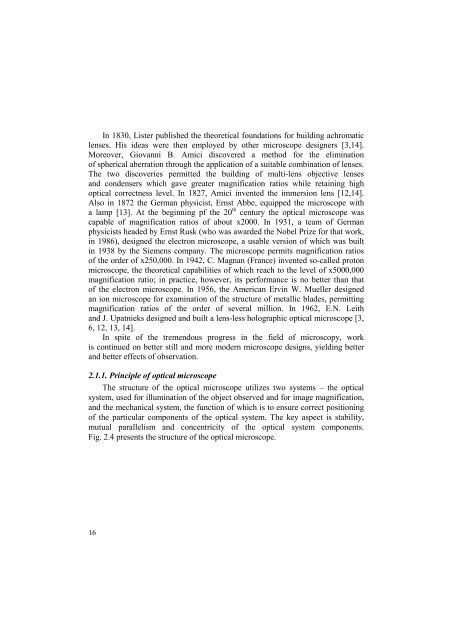MICRO-STRUCTURE ANALYSIS OF PLANT TISSUES - Lublin
MICRO-STRUCTURE ANALYSIS OF PLANT TISSUES - Lublin
MICRO-STRUCTURE ANALYSIS OF PLANT TISSUES - Lublin
Create successful ePaper yourself
Turn your PDF publications into a flip-book with our unique Google optimized e-Paper software.
In 1830, Lister published the theoretical foundations for building achromatic<br />
lenses. His ideas were then employed by other microscope designers [3,14].<br />
Moreover, Giovanni B. Amici discovered a method for the elimination<br />
of spherical aberration through the application of a suitable combination of lenses.<br />
The two discoveries permitted the building of multi-lens objective lenses<br />
and condensers which gave greater magnification ratios while retaining high<br />
optical correctness level. In 1827, Amici invented the immersion lens [12,14].<br />
Also in 1872 the German physicist, Ernst Abbe, equipped the microscope with<br />
a lamp [13]. At the beginning pf the 20 th century the optical microscope was<br />
capable of magnification ratios of about x2000. In 1931, a team of German<br />
physicists headed by Ernst Rusk (who was awarded the Nobel Prize for that work,<br />
in 1986), designed the electron microscope, a usable version of which was built<br />
in 1938 by the Siemens company. The microscope permits magnification ratios<br />
of the order of x250,000. In 1942, C. Magnan (France) invented so-called proton<br />
microscope, the theoretical capabilities of which reach to the level of x5000,000<br />
magnification ratio; in practice, however, its performance is no better than that<br />
of the electron microscope. In 1956, the American Ervin W. Mueller designed<br />
an ion microscope for examination of the structure of metallic blades, permitting<br />
magnification ratios of the order of several million. In 1962, E.N. Leith<br />
and J. Upatnieks designed and built a lens-less holographic optical microscope [3,<br />
6, 12, 13, 14].<br />
In spite of the tremendous progress in the field of microscopy, work<br />
is continued on better still and more modern microscope designs, yielding better<br />
and better effects of observation.<br />
2.1.1. Principle of optical microscope<br />
The structure of the optical microscope utilizes two systems – the optical<br />
system, used for illumination of the object observed and for image magnification,<br />
and the mechanical system, the function of which is to ensure correct positioning<br />
of the particular components of the optical system. The key aspect is stability,<br />
mutual parallelism and concentricity of the optical system components.<br />
Fig. 2.4 presents the structure of the optical microscope.<br />
16

















